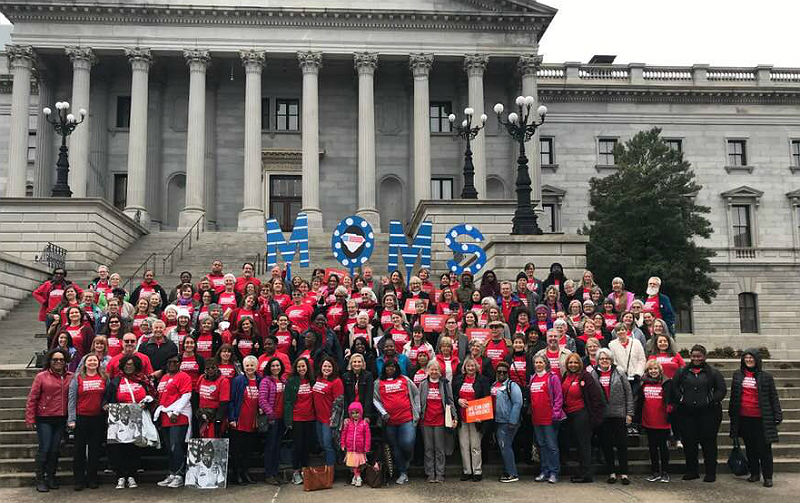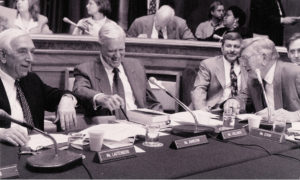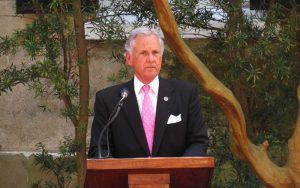
Editor’s Note: The following article on South Carolina politics is part of the newly-published 2020 edition of the Almanac of American Politics. We have partnered with the Almanac to provide it to our readers to give a general overview of what’s ahead in S.C. politics in the coming year.
By Louis Jacobson, copyrighted material republished with permission | History is inescapable anywhere, but especially so in the South — as Americans have been reminded in recent years, when South Carolina has repeatedly been vaulted into the headlines for tragic incidents and efforts at reconciliation.
 In 2015, a gunman with a history of white supremacist beliefs entered a historic African-American church in Charleston, sat down for Bible study, and then systematically gunned down nine black worshippers — including the pastor, state Sen. Clementa Pinckney – as he squeezed the trigger more than 75 times. Amid the mourning, a debate about an old subject — race and Confederate heritage— reemerged. Critics said the state should finally do what it had previously balked at — remove the Confederate battle flag from the state capitol grounds in Columbia, where it had flown, in one way or another, since the depths of the civil rights conflict in 1962. Republican Gov. Nikki Haley, who prior to the killings had shown little interest in following her predecessors’ (failed) efforts to pull down the flag, offered her support for removal, and the tide began to turn. The legislature gave its approval, and on July 10, 2015, the flag was lowered from the statehouse grounds for good. The shooter, Dylann Roof, was sentenced to death in 2017 — the nation’s first federal hate-crime defendant to face the death penalty. Meanwhile, another high-profile case – a videotaped police shooting in North Charleston in which a black man, Walter Scott, was shot in the back by a white police officer –produced first a deadlocked jury and then a plea agreement that resulted in a 20-year prison sentence.
In 2015, a gunman with a history of white supremacist beliefs entered a historic African-American church in Charleston, sat down for Bible study, and then systematically gunned down nine black worshippers — including the pastor, state Sen. Clementa Pinckney – as he squeezed the trigger more than 75 times. Amid the mourning, a debate about an old subject — race and Confederate heritage— reemerged. Critics said the state should finally do what it had previously balked at — remove the Confederate battle flag from the state capitol grounds in Columbia, where it had flown, in one way or another, since the depths of the civil rights conflict in 1962. Republican Gov. Nikki Haley, who prior to the killings had shown little interest in following her predecessors’ (failed) efforts to pull down the flag, offered her support for removal, and the tide began to turn. The legislature gave its approval, and on July 10, 2015, the flag was lowered from the statehouse grounds for good. The shooter, Dylann Roof, was sentenced to death in 2017 — the nation’s first federal hate-crime defendant to face the death penalty. Meanwhile, another high-profile case – a videotaped police shooting in North Charleston in which a black man, Walter Scott, was shot in the back by a white police officer –produced first a deadlocked jury and then a plea agreement that resulted in a 20-year prison sentence.

In reality, tragedy and coexistence have been dueling parts of South Carolina’s history from the beginning. The state’s early influence was the slave-majority, sugar-producing island of Barbados, which produced its original settlers; until 1855, South Carolina was the only southern colony or state with a black majority. On the one hand, Carolina plantation owners were tolerant of some groups, opening their colony to French Huguenots and Sephardic Jews. At the same time, they were also slave masters of giant plantations that produced rice and indigo. Indeed, the predecessor of the very same church where the 2015 shootings occurred was the epicenter of the 1822 slave rebellion led by Denmark Vesey, which ended with the execution of Vesey and numerous lieutenants, as well as the destruction of the church. (Before his death, Pastor Pinckney had been active in erecting a memorial to Vesey.) South Carolinian Charles Pinckney led the effort to enshrine the principle of no religious tests for political office in the Constitution; he was also a slaveholder. The Lowcountry planters maintained control of the legislature, and therefore the state’s two Senate seats and presidential electors, up through 1860. In that year and the next, South Carolina did more than any other state to precipitate the Civil War. In December, after the election of Abraham Lincoln, the South Carolina legislature voted to secede from the Union and was soon followed by other states. And in April 1861, a cannon in Charleston fired on Union troops at Fort Sumter.

Defeat in the Civil War transformed South Carolina. The state’s slaves, 57 percent of the population in 1860, were freed. One of the wealthiest states became one of the poorest. Some 30 percent of military-age white males were killed. Reconstruction briefly gave black Republicans political control, but the backlash was fierce once federal troops left; strict racial segregation and voting restrictions, including the poll tax, kept most South Carolinians disenfranchised. As late as 1944, in a state of 2 million people, only 103,000 voted for president, with 88 percent of them voting Democratic. The Lowcountry languished in poverty, with malnutrition on coastal islands. A silver lining was architectural — the old mansions of Charleston were not replaced by commercial buildings, and instead were saved by the nation’s first local historic preservation movement (and rebuilt after Hurricane Hugo in 1989), cementing the city’s culture and civic pride. Mostly white Upstate South Carolina, with a growing textile industry, took the political lead, led by such politicians as Pitchfork Ben Tillman (governor 1890-94, senator 1895-1918) and a close friend’s son, Strom Thurmond (governor 1947-51, senator 1954-2003).
In the last few decades, this once underdeveloped state has taken steps forward. Most South Carolina whites opposed integration, but unlike in Alabama and Mississippi, the effort was mostly not punctuated by violence. The Civil Rights Act of 1964 and the Voting Rights Act of 1965 ended legal segregation of public accommodations and workplaces and brought blacks into the electorate. Democratic (and later Republican) Sen. Thurmond, who staged a record-setting filibuster of the 1957 Civil Rights Act, began appointing black staffers and signed off on a black federal judge. By the 21st century, the state elected Haley, a daughter of immigrants from India, and then Tim Scott, an African-American, to the House and later to the Senate, respectively; in this strongly conservative state, their ideology was what mattered.

In many ways, the biggest change has been economic. Forty years ago, much of South Carolina’s economy depended on military bases and big textile mills in the Interstate 85 corridor around Greenville and Spartanburg. Then South Carolina became the most aggressive state in the South in seeking new industry. It advertised its business climate, with one of the nation’s lowest rates of unionization and taxation and a willingness to splurge on tax incentives. Crucially, Democratic Gov.(later Sen.) Ernest Hollings spearheaded the creation of the state’s technical colleges, which today educate and train hundreds of thousands of residents a year. Michelin opened the first of several South Carolina plants in 1975, and the first BMW vehicles rolled off the Spartanburg assembly line in 1992. Volvo chose a South Carolina site 30 miles northwest of Charleston as the location of its first North American assembly plant, while smaller companies built factories throughout much of central and Upstate South Carolina.
Navy bases were the mainstay of Charleston’s economy in the 1970s, but they were closed in the early 1990s, subsequently becoming a center of aircraft production, particularly after Boeing in 2009 chose North Charleston to build a plant to assemble its 787 Dreamliner. The aircraft giant now employs 6,800 people in the Charleston area, though the company has been enmeshed in a contentious battle over unionization; one major organizing effort was rejected in a vote, but a narrower one succeeded in 2018. Charleston has become a major port, which is especially helpful for the state’s international exporters; the state has scrambled to line up the funds to carry out a $558 million, multi-year plan to dredge Charleston Harbor so container ships can traverse it regardless of tidal conditions. Charleston’s downtown has not only survived but thrived, thanks in large part to the creative energy of longtime Mayor Joseph P. Riley Jr., who was first elected in 1975 and who served for 40 years. With a keen aesthetic eye, he made the city’s historic center a magnet for tourists; statewide, tourism has grown consistently, reaching $21.2 billion in 2016, an amount bigger than the $16 billion statewide impact of the military. By late 2018, the unemployment rate had fallen to 3.3 percent, slightly below the national average.
Through the 1960s, few people except military personnel moved to South Carolina. That has changed in a big way. In 2018, United Van Lines reported that South Carolina was the sixth-most popular destination for interstate moves. Since 2010, the population has grown by 9.7 percent, with growth fastest on and near the coast – 20 percent in Horry County (Myrtle Beach) and Berkeley County (the northern suburbs of Charleston), 17 percent in Dorchester County (the northwestern suburbs of Charleston), 15 percent in Beaufort County (Hilton Head), and 13 percent in Charleston County (Charleston). Another growth area has been the York County suburbs of booming Charlotte, North Carolina; it grew by 17 percent. These booming areas attract tourists and affluent retirees eager to spend days with pleasant weather on the golf course and in time-shares. The newcomers are disproportionately white and conservative; South Carolina’s population is 27 percent black (tied for the fifth highest in the nation, although far below African-Americans’ near-majority of the 1940s) and 6 percent Hispanic. The fastest-growing portion of South Carolina’s population now consists of those 85 and older, and by 2030, the state is expected to have more residents 65 and older than children in school.
 Despite the economic gains, South Carolina had no locally headquartered company on the Fortune 500 list in 2018, and business leaders worried about the impact of President Donald Trump’s protectionist trade policies. After tariffs began to hit, BMW shifted some of its production to China, and Daimler, which was building a plant in North Charleston, said it might need to follow suit; Volvo warned that it may hire fewer workers at its plant. The state’s exports fell in 2018 for the first time in years, and television maker Element Electronics near Columbia shut down entirely due to higher costs from tariffs. But the state’s Republican politicians hung with Trump for the most part, saying they hoped the approach would produce long-term gains despite short-term pain.
Despite the economic gains, South Carolina had no locally headquartered company on the Fortune 500 list in 2018, and business leaders worried about the impact of President Donald Trump’s protectionist trade policies. After tariffs began to hit, BMW shifted some of its production to China, and Daimler, which was building a plant in North Charleston, said it might need to follow suit; Volvo warned that it may hire fewer workers at its plant. The state’s exports fell in 2018 for the first time in years, and television maker Element Electronics near Columbia shut down entirely due to higher costs from tariffs. But the state’s Republican politicians hung with Trump for the most part, saying they hoped the approach would produce long-term gains despite short-term pain.
Not even the export-driven growth has managed to extinguish poverty in many areas of the state. In 2016, five whole counties and parts of several others reported more than 95 percent of their schoolchildren qualifying for free or reduced-cost lunches or Medicaid. Statewide median income is 16 percent below the national average, and the poverty rate is a few percentage points higher than the national average. South Carolina ranked in the bottom quarter of states for the percentage of residents with a college degree, and large percentages of new – and even experienced – teachers have left the state’s schools, and even the profession entirely, according to The State newspaper.
The demographic changes have moved South Carolina politically toward Republicans. Politics cleaves the electorate along racial lines, and the hard math of the population figures — whites have an easy majority — makes it difficult for Democrats to win statewide. South Carolina has voted for Republicans for president in every election but one since 1960 – in 1976, when son of the South Jimmy Carter was running. With some bare-knuckled help from wunderkind strategist Lee Atwater, former Gov. Carroll Campbell built a Republican Party capable of electing statewide officials and legislative majorities. In 1988, Campbell and Atwater, who was by then George H.W. Bush’s campaign manager, set up the early Republican presidential primary on the Saturday before Super Tuesday, which enabled Bush to clinch the nomination that year. It did the same for Bob Dole in 1996, for George W. Bush in 2000, and for John McCain in 2008. The only hiccup came in 2012, when Newt Gingrich won the state.

In 2016, Donald Trump won all but two counties in South Carolina’s primary, and easily won the state in the general election. South Carolinians remained supportive of the embattled president, which led such leading GOP figures as Sen. Lindsey Graham and Gov. Henry McMaster to cement close ties with Trump. Haley, as U.N. ambassador, and former Rep. Mick Mulvaney, in several White House positions including acting chief of staff, served in high-profile administration roles. Trump helped push GOP primaries toward loyalists, including a primary challenger who ousted Rep. Mark Sanford for being insufficiently supportive. That move backfired in the general election when the Democrats flipped the seat, but that race was the exception. Not even a long-unfolding investigation of Richard Quinn, a powerbroker with deep influence in the legislature who was indicted on perjury charges in April 2019, hurt Republican prospects in the state, despite several indictments of legislators and other political figures. Today, even attractive Democratic candidates find it hard to secure more than 45 percent of the vote in South Carolina.
“Copyright @ 2019 The Almanac of American Politics. This feature was provided by and is included in The Almanac of American Politics 2020 edition, which has just been released. To learn more about this publication or purchase a copy, visit www.almanacofamericanpolitics.com.”
- Have a comment? Send to: feedback@statehousereport.com.















 We Can Do Better, South Carolina!
We Can Do Better, South Carolina!